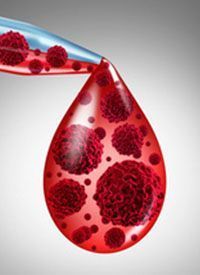Ruxolitinib/Pomalidomide Combo Shows Feasibility in Myelofibrosis With Anemia
A combination regimen comprised of ruxolitinib and pomalidomide was found to be safe and feasible in a cohort of intermediate-2 and high-risk patients with primary or secondary myelofibrosis and anemia, according to data from the phase 1b/2 MPNSG-0212 trial.

A combination regimen comprised of ruxolitinib (Jakafi) and pomalidomide (Pomalyst) was found to be safe and feasible in a cohort of intermediate-2 and high-risk patients with primary or secondary myelofibrosis and anemia, according to data from the phase 1b/2 MPNSG-0212 trial (NCT01644110).1
Data from cohort 1 (n = 39) showed that the combination elicited a response rate of 21% at the end of cycle 12, with a clinical benefit rate (CBR) of 13%; 67% of patients did not respond to/ did not derive clinical benefit from the treatment. Clinical benefit was assessed retrospectively for this cohort. Forty-six percent of the 39 patients continued treatment beyond this cycle, 38% received treatment for more than 30 cycles, and 8% were on long-term treatment.
Among those in cohort 2 (n = 49), the response rate achieved at the end of cycle 12 was 10%, with a CBR of 29%; 61% of patients did not respond or derive clinical benefit from treatment. For this cohort, clinical benefit was prospectively evaluated. In this group, 39% continued treatment beyond this cycle, 6% received treatment for more than 30 cycles, and 6% were still on treatment.
Additionally, the median overall survival (OS) was found to be shorter in cohort 2 vs cohort 1, at 2.6 years and 3.6 years, respectively, although this difference between the cohorts was not determined to be statistically significant.
Although treatment with ruxolitinib has been shown to alleviate disease-associated symptoms such as splenomegaly in this patient population, cytopenia management continues to be a challenge. Prior data from the MPNSG-0109 trial showed that pomalidomide monotherapy improved cytopenia by 14% when given at a once-daily dose of 0.5 mg, and by 29% when given at a once-daily dose of 2 mg.
These findings supported the rational to explore the doublet in patients with myelofibrosis and anemia, defined as having hemoglobin of less than 10 g/dL and/or red blood cell (RBC) transfusion dependency.
The academic, open-label, phase 1b/2 trial enrolled those with primary or secondary myelofibrosis and anemia who had a platelet count of greater than 100/nL and were not eligible to undergo stem cell transplantation. Patients could not have previously received an immunomodulatory drug within the past 3 months or ruxolitinib within the past 14 days.
Key efficacy end points at the end of cycle 12 included response rate according to International Working Group-Myeloproliferative Neoplasms Research and Treatment criteria, RBC transfusion independency rate, and clinical benefit. Investigators also evaluated safety, quality of life, progression-free survival, and OS.
Cohort 1 received ruxolitinib at a twice-daily dose of 10 mg in combination with pomalidomide administered at a fixed dose of 0.5 mg daily. Cohort 2 received ruxolitinib at 10 mg twice daily plus pomalidomide starting at 0.5 mg, increased to 1 mg after cycle 3 in 73% of patients, and to 2 mg following cycle 6 in 40% of patients.
Dose modifications were allowed, and investigators evaluated patients every 28 days.
Of the 92 patients enrolled to the trial, 88 had evaluable clinical data at the end of cycle 12; this included 39 patients in cohort 1 and 49 patients in cohort 2. Six patients were still on therapy following cycle 12; this included 3 patients from cohort 1 and 3 patients from cohort 2. Eighty-two patients discontinued treatment: 36 patients from cohort 1 and 46 patients from cohort 2. The median duration of treatment in cohort 1 (range, 2-98) and cohort 2 (range, 3-46) was 12 cycles.
The median age of patients in cohort 1 was 72 years (range, 49-83) vs 70 years (range, 52-86) in cohort 2; 15% and 44% of patients, respectively, had pretreatment with ruxolitinib. Moreover, 26% of those in cohort 1 had RBC transfusion dependency at baseline vs 35% of those in cohort 2. Regarding risk per the Dynamic International Prognostic Scoring System, 3% of those in cohort 1 had low-risk disease, 8% had intermediate-1 risk disease, 64% had intermediate-II risk disease, and 25% had high-risk disease; in cohort 2, these rates were 0%, 8%, 67%, and 26%, respectively.
Additional data presented during the 2022 EHA Congress showed that pretreatment with ruxolitinib did not impact OS or treatment response with the combination.
Moreover, in 92 patients, 418 mutations were detected, with a median of 5 mutations per patient (range, 1-11). In cohort 1, 54% of patients had at least 1 HMR mutation vs 57% of those on cohort 2. The frequency of mutations in ASXL1, SRSF2, EZH2, and IDH2 were found to be comparable between the cohorts.
Overall, targeted next-generation sequencing of 269 genes did not showcase a distinct mutational pattern linked with response to the doublet. However, investigators did not that those who had more than 3 mutations experienced a worse median OS vs those who did not, at 1.2 years vs 4 years (P = .002).
More detailed analyses are ongoing.
Regarding safety, serious adverse effects reported with the regimen, irrespective of cohort, included pneumonia, leukemic transformation, central nervous system ischemia, septic shock or sepsis, cardiac decompensation, hemoglobin, joint infection, and febrile neutropenia.
Reference
Stegelmann F, Jahn E, Koschmieder S, et al. Clinical and genetic results of the phase IB/II trial MPNSG-0212: ruxotlinib plus pomalidomide in myelofibrosis with anemia. Presented at: 2022 EHA Congress; June 9-12, 2022; Vienna, Austria.



